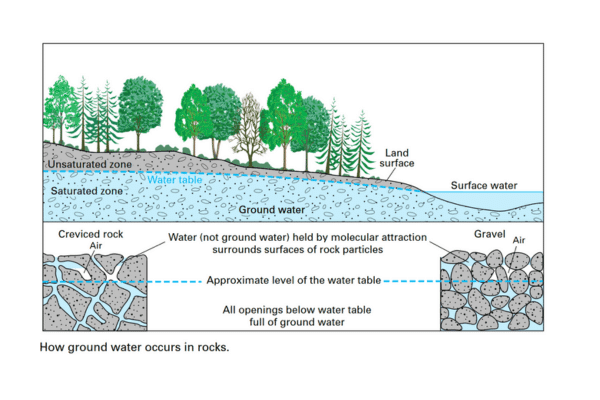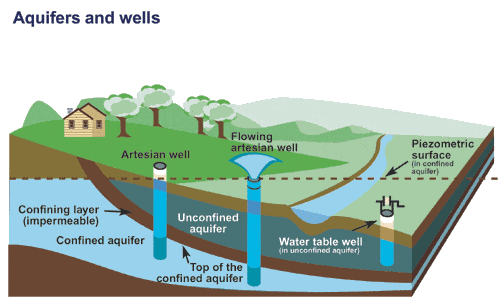What is an Aquifer?
I’ve always been fascinated by the hidden world beneath our feet. Aquifers, those underground reservoirs of water, hold a mysterious allure. I remember a trip to the countryside where I first learned about the significance of aquifers in sustaining life above ground. My guide explained how these geological formations store and transmit groundwater, serving as a vital source of water for agriculture, drinking, and industrial purposes.
In simple terms, an aquifer is like a natural underground sponge, made up of layers of rock, sand, or gravel that can hold and transmit water. Imagine a giant sponge sandwiched between layers of impermeable rock. When rain falls, some of it seeps into the ground, filling up the spaces within the sponge-like aquifer.
Define an Aquifer.
An aquifer is a body of permeable rock that can contain or transmit groundwater. It acts as a natural storage system, holding water underground. Aquifers are crucial for providing water for various purposes, including drinking, irrigation, and industrial use.
How do Aquifers Form?
Aquifers form over thousands of years through geological processes. They are typically composed of porous rocks, such as sandstone or limestone, which can hold water. Over time, these rocks become saturated with water, creating an aquifer.
Why are Aquifers Important?
Aquifers are essential because they store and transmit groundwater, which is a vital source of water for many communities. They also help regulate the flow of rivers and streams, ensuring a stable water supply during dry periods.
How do Aquifers Impact the Environment?
Aquifers play a crucial role in the environment by supporting ecosystems and providing water for plants and animals. They also help maintain water levels in rivers and lakes, which is essential for biodiversity.
What are 4 examples of aquifers?
Aquifers can be classified into several types based on their geological characteristics and the way they store and transmit water. Some common types of aquifers include:
- Unconfined Aquifers: These aquifers have a water table that is not confined by impermeable layers above them. They are typically recharged directly by precipitation and are more susceptible to contamination.
- Confined Aquifers: Confined aquifers are sandwiched between impermeable layers, known as aquitards or confining layers. These layers restrict the movement of water into and out of the aquifer, creating higher pressure within the aquifer.
- Perched Aquifers: Perched aquifers are localized zones of saturation that occur above the main water table, typically held in place by an impermeable layer below. They are often small and can be found in hilly or sloping terrain.
- Leaky Aquifers: Leaky aquifers are characterized by the presence of both permeable and impermeable layers, allowing water to flow slowly between adjacent aquifers.
Sources/Usage: Public Domain. View Media Details
Artisan Aquifers: Artisan aquifers are confined aquifers where water is under enough pressure to rise above the land surface without the need for pumping. These aquifers often result in natural springs.
Aquicludes and Aquitards: While not aquifers themselves, aquicludes and aquitards are important in aquifer systems. Aquicludes are impermeable layers that prevent the movement of groundwater, while aquitards are semi-permeable layers that slow down the movement of groundwater.
What does an aquifer look like?
Where is the largest aquifer in the world?
an aquifer is typically composed of freshwater, although there are instances where it may contain saline or brackish water. Four examples of aquifers include the Ogallala Aquifer in the United States, the Guarani Aquifer in South America, the Great Artesian Basin in Australia, and the Nubian Sandstone Aquifer System in North Africa.
Aquifers can vary in appearance depending on their composition, but they are generally underground layers of permeable rock or sediment that hold and transmit water. The largest aquifer in the world is the Ogallala Aquifer, also known as the High Plains Aquifer, which spans across eight states in the United States.
Is an Aquifer Freshwater?
Yes, typically, an aquifer contains freshwater. However, some aquifers may also contain saline or brackish water depending on factors such as geological conditions and proximity to coastal areas.
Four Examples of Aquifers
Four examples of aquifers include the Ogallala Aquifer in the United States, the Guarani Aquifer in South America, the Great Artesian Basin in Australia, and the Nubian Sandstone Aquifer System in North Africa. These aquifers are significant sources of freshwater for their respective regions.
What Does an Aquifer Look Like?
Aquifers vary in appearance depending on their geological composition and location. Generally, an aquifer appears as an underground layer of permeable rock or sediment that can hold and transmit water. It may consist of materials such as sandstone, limestone, or gravel, with water filling the pore spaces within these formations.
Where Is the Largest Aquifer in the World?
The largest aquifer in the world is the Ogallala Aquifer, also known as the High Plains Aquifer. It spans across eight states in the United States, including parts of South Dakota, Nebraska, Wyoming, Colorado, Kansas, Oklahoma, New Mexico, and Texas. The Ogallala Aquifer is a vital source of freshwater for agriculture and communities in the region.
Sources/Usage: Public Domain. View Media Details
Groundwater and Aquifers:
Groundwater refers to the water found underground in the cracks and spaces in soil, sand, and rock. Aquifers are underground layers of rock or sediment that can hold and transmit groundwater. They are crucial sources of freshwater, serving as natural reservoirs that store water for human use and environmental needs.
Visualizing Groundwater:
Visualizing groundwater can be challenging since it is hidden underground. However, imagine an aquifer as a vast, invisible underground river, flowing through layers of rock and sediment. Just like a river on the surface, groundwater moves in response to gravity and the pressure exerted by the water above it.
Pumping Can Affect the Level of the Water Table: When water is pumped from wells, it can lower the level of the water table, which is the upper surface of the groundwater. Over-pumping can lead to a decline in the water table, affecting the availability of groundwater for drinking, irrigation, and other uses.
Water Movement in Aquifers:
Water moves through aquifers in a process called groundwater flow. This movement occurs as water percolates down from the surface through the soil and rock layers until it reaches the saturated zone, where all the pore spaces are filled with water. The water then flows horizontally through the aquifer, following the natural gradient of the land.
Conclusion
Aquifers are more than just underground reservoirs; they are the lifeblood of many communities around the world. Understanding the importance of these hidden water sources is key to ensuring their sustainable management for future generations. So, the next time you turn on the tap or water your garden, take a moment to think about the aquifers beneath your feet, silently providing the water we all depend on.

